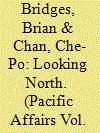| Srl | Item |
| 1 |
ID:
095143


|
|
|
| 2 |
ID:
085884


|
|
|
|
|
| Publication |
2009.
|
| Summary/Abstract |
On the 5th January 2007 the first high-express trains began to run between Taiwan's largest two cities, Taipei and Kaohsiung, Modelled on Japan's highly successful shinkansen (bullet trains), these trains were not just a significant export success for Japanese manufactures, but also symbolized th extent to which Taiwan's relationship wuth Japan has been quietly but steadily developing.
|
|
|
|
|
|
|
|
|
|
|
|
|
|
|
|
| 3 |
ID:
155763


|
|
|
|
|
| Summary/Abstract |
Starting in the early 1950s, the Japanese flag hi no maru was a cherished symbol in Okinawa of the movement for an end to the postwar U.S. military occupation and reversion to Japanese sovereignty. The flag represented an appeal for liberation from U.S. military rule that dragged on for twenty years (1945–1972) after mainland Japan regained its sovereignty in 1952; and, for elimination, or at least reduction, of the overwhelming size and number of American bases on the island. However, the 1969 Okinawa Reversion Agreement between the U.S. and Japanese governments broke both of the Japanese government’s promises that, after reversion, Okinawa would have no nuclear weapons, and that U.S. bases would be reduced to mainland levels. The grossly disproportionate U.S. military remains to this day, and a “secret agreement” permits the United States to bring back nuclear weapons. Today many in Okinawa associate hi no maru with this discriminatory policy which imposes 74 percent of the total U.S. military presence in Japan on this small island prefecture comprising 0.2 percent of the nation’s land area. For historians, the flag also represents atrocities committed by Imperial Japanese soldiers during the Pacific War and the Japanese government’s continuing reluctance to acknowledge them.
|
|
|
|
|
|
|
|
|
|
|
|
|
|
|
|